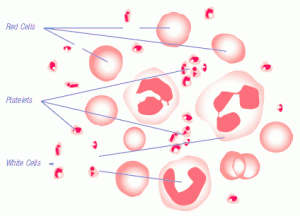Red blood cells are the most common type of blood cells in our body and they play the most important duty of all. These blood cells carry along oxygen and deliver them to the different body tissues from the lungs to the heart and other parts. Oxygen is the tissues main source of energy, without them they would wither. Our body contains 20-30 trillion of red blood cells and a single drop would contain millions of these cells, without them our bodies would slowly die. An adult person needs normal RBC levels for the body to function well and survive. A high or low of this blood count would at times indicate infections or diseases.
What Is a Red Blood Cell Count?
A red blood cell (RBC) count is used to determine if a person has normal RBC level present in the body. This test is used to determine if the person has high or low red blood cell count. A normal RBC level of a person varies from the age and sex. An adult woman has 4.2 to 5.4 million red cells per microliter while a man has 4.7 to 6.1 million red cells per microliter; and these counts differ from children who have normal RBC levels of 4.6 to 4.8 million per microliter.
High RBC Count Level
A high RBC level would indicate a wide range of conditions such as:
• Dehydration
• Polycythemia vera
• Pulmonary disease
• Over transfusion
• Congenital heart disease
• Renal problems
• Tissue hypoxia
• Pulmonary fibrosis
• Kidney cancer
• Hemoglobinopathies (a condition that may be present since birth that impairs the red blood cells from their normal oxygen-carrying capacity)
Causes of increase in the normal RBC levels might be results of one or more of the following instances:
• An increase in red blood cell production due to a low oxygen level because of a poor lung or heart function
• When the kidney releases too many proteins which enhance the production of red blood cells
• Bone marrow conditions that result to over producing of red blood cells
• Impaired capacity of the red blood cells in carrying oxygen
• Loss of blood plasma in the blood results to high level of RBC count
• Kidney transplant
• Living in a place where less oxygen is present especially at high altitude places
• Smoking
• EPO doping erythropoietin (EPO) injections that enhances athletics performances
• Taking of anabolic steroids
An increase in the normal RBC levels could either be a result of a temporary or a chronic condition. It is impossible to determine the root cause without the help of a medical professional. A person with high RBC levels needs to see his doctor for further evaluation and screening to determine the cause of changes. Treatment may also vary according to the conditions present.
Low RBC Level
A low RBC level may indicate certain health conditions such as:
• Trauma
• Burns
• Bone marrow damage
• Hemolytic anemia
• Pregnancy
• Hemorrhagic infections
• Iron deficiency anemia
• Gastrointestinal infections or other vascular bleeding
• Vitamin B12 deficiency
• Metabolic disorders
• Chronic inflammation
It’s not at all times that a person with low RBC level has a serious health condition. For some it might just be their normal RBC levels, such as when a woman is pregnant or just starting with her menstrual period. But decrease in the normal RBC levels might be an indication of other serious conditions like leukemia and other types of cancers. In most cases cancer treatment like chemotherapy and radiation therapy can cause damage and shortage of red blood cells. Blood loss is another cause of a low RBC level.
Symptoms of a person with low RBC level are:
• Fatigue
• Shortness of breath
• Weak feeling
• Increase in the heart rate
• Dizziness or light headedness especially when changing positions
• Headaches
• Chest pain
• Pale skin
Sometimes there are no noticeable symptoms but when a person is experiencing any of the symptoms stated above it is best to have a complete blood count test including a red blood cell count, hemoglobin, and hematocrit tests. These tests would help determine the type of condition you have and for the doctors to be able to give the right treatment.
How long would the red blood cells go back to the normal RBC levels?
While an average red blood cell has a life span of 100 – 120 days, re-acquiring the normal RBC levels is a long, slow process. Our bodies continuously create more blood, and eliminating the cause of the high and low RBC levels can easily be corrected through medications. Some doctors might suggest taking multivitamins and iron supplements as well as keeping a healthy diet with adequate intake of foods rich in protein and vitamins and having a good rest.

Hello there, You’ve done an incredible job. I抣l certainly digg it and personally recommend to my friends. I’m confident they will be benefited from this website.